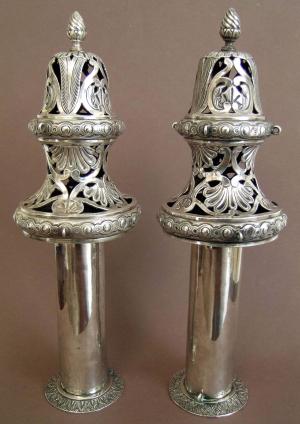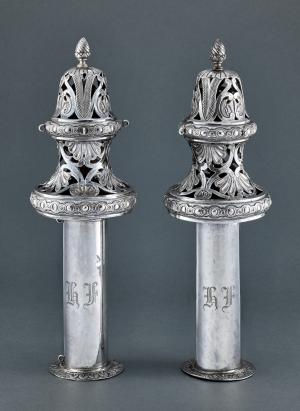Obj. ID: 37132
Sacred and Ritual Objects Torah finials, Strasbourg, circa 1850

The following description was prepared by William Gross:
The finials evolved from knobs at the upper end of the staves (Atzei Chaim) on which the Torah scroll is wound. Since the shape of the spherical finial recalled that of a fruit, it was called a tappu'aḥ, "apple," among the Jews of Spain and in the Sephardi Diaspora, and a rimmon, "pomegranate," in all other communities.
The earliest known reference to Torah finials occurs in a document from 1159, found in the Cairo Genizah, from which we learn that by the 12th-century finials were already being made of silver and had bells. Around the same time, Maimonides mentions finials in the Mishneh Torah (Hilkhot Sefer Torah 10:4). Despite the variations on the spherical shape which developed over the centuries and the addition of small bells around the main body of the finial, the spherical, fruit-like form was the basic model for the design of finials in Oriental and European communities.
A most significant variation appeared in 15th-century Spain, Italy, and Germany, where the shape of finials was influenced by that of various objects of church ritual, whose design often incorporated architectural motifs, The resulting tower-like structure, which seems to have appeared around the same time in different parts of Europe, became the main type of finial in 18th-century Germany and Italy, as well as Morocco, brought there by Jews expelled from Spain.
The very wide tubes and the general shape of these Rimmonim identify them as French. On the tubes is a pair of gothic initials, "H" & "F". These same initials, in exactly the same gothic script, are found on a 1680 Tas in the Gross Family collection from Strasbourg (051.001.022). It is likely that the Rimmonim, from the middle of the nineteenth century, were made and dedicated at a time that the Tas was repaired and rededicated. The engraving of the initials on both objects indicates the donation for both was made by the same person. It is clear as well that at the time of the dedication both objects were still in Alsace.
Inscription: Gothic Letters "R" & "F"
sub-set tree:
O | Ornamentation: | Ornament
O | Ornamentation: | Foliate and floral ornaments | Floral motif
|






